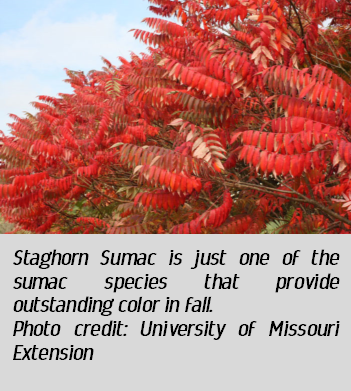|
|
by Cathy Bylinowski, Horticulture Instructor, adapted from an October, 2019 Missouri Environment and Garden article by Dr. David Trinklein, Horticulture Specialist, University of Missouri. While trees command most of our attention when it comes to fall foliage color, do not overlook their more diminutive relatives. In home landscapes as well as in the wild, woody shrubs also provide fall color to enhance outdoor living are as well as add beauty to the season. At a time when many summer flowers are finished blooming, colorful shrubs can extend garden enjoyment.
Shrubs that provide fall color are not restricted to those planted in home landscapes. Many occur in nature. They are enjoyed as outdoor enthusiasts search for colorful fall scenes. Indeed, early autumn excursions are more enjoyable because of the bright red leaves of native sumacs such as fragrant sumac (Rhus aromatica) and smooth sumac (Rhus glabra), often seen growing along roadsides. These two species also are suitable for the home landscape and will provide good fall color in addition to interest at other seasons as well. A bit more decorative, cut-leaf staghorn sumac (Rhus typhina 'Laciniata') is another useful sumac selected from a native sumac species. Capable of growing to a height of 20 feet, it boasts large, deeply divided leaves that turn from a beautiful orange to a fiery red in the fall. It needs room, however, since it tends to spread via root suckers to form a clump. Like other sumacs, it is durable and tolerates poor soil along with dry, sunny exposures. Tiger-eyes sumac (Rhus typhina 'Bailtiger') is yet another selection of staghorn sumac. It boasts chartreuse green foliage in the spring, yellow foliage during the summer and fiery orange foliage in the fall. Shorter than cut-leaf staghorn sumac, it grows to a height of about six feet. One of the lesser-known shrubs that provides good reddish-purple fall color is Oakleaf hydrangea (Hydrangea quercifolia), a native of the Southeast U.S. In addition to attractive fall foliage color, this hydrangea produces white flowers in early summer that turn pinkish purple by mid-summer and brown in the fall. This is possible because the showy appendages of the flowers are long-lived bracts and not petals. While it can tolerate some sun, Oakleaf hydrangeas prefer part shade/part sun. Dozens of useful cultivars of the species are available. One of the best is ‘Snowflake’, which produces huge eight-inch panicles that often bend down the shrub's branches because of their abundance. Shrubs that also exhibit some fall color while being good landscape specimens are the viburnums. They include American cranberry bush (Viburnum trilobum) and Korean spice viburnum (Viburnum carlesii). Most develop red or reddish-purple fall foliage color. Additionally, they bear attractive (and often fragrant) flowers in the spring. Some regional native viburnums such as Black Haw (Viburnum prunifolium) and Rusty Black Haw (Viburnum rufidulum) also provide edible berries for humans and wildlife. Smaller dogwoods are another group of woody plants that develop attractive reddish-purple fall leaf color. The shrubby types, such as silky dogwood (Cornus amomum) or red osier dogwood (Cornus sericea) are good choices for landscape use, given the proper setting. They grow from between six to ten feet in height and almost as wide. Where space is available, they make durable, low-maintenance shrubs that add beauty to the landscape. The red osier dogwood, commonly called red twig dogwood, has reddish bark, which provides color throughout the winter. Common witch-hazel Native witch-hazels (Hamamelis virginiana and Hamamelis vernalis) produce bright yellow leaves in fall. This woody species develops into a large shrub or a small tree. In addition to yellow-colored fall leaves, this plant can produce yellow-orange flowers after its leaves drop. Nurseries that carry regional native plants often carry both native witch-hazel species. Colorful shrubs provide a special "finishing touch" to the landscape. They can add to the enjoyment of fall foliage color, one of nature's treats. Perhaps its fleeting appearance is one reason the annual spectacle is so highly anticipated. When looking up to admire fall tree color, take time to look down and enjoy the color some of our woody shrubs provide. For more gardening information, contact University of Missouri Extension, 816-252-5051. Comments are closed.
|
Categories
All
Archives
July 2024
|
Grain Valley NewsGrain Valley News is a free community news source published weekly online. |
Contact Us |


 RSS Feed
RSS Feed
